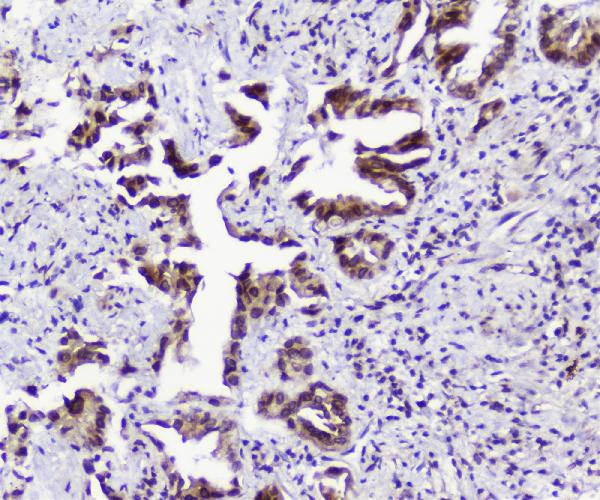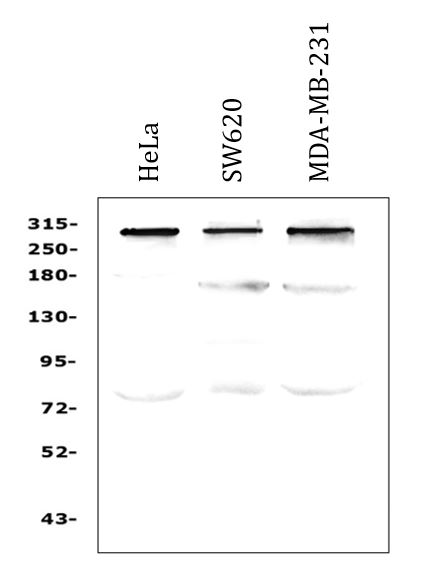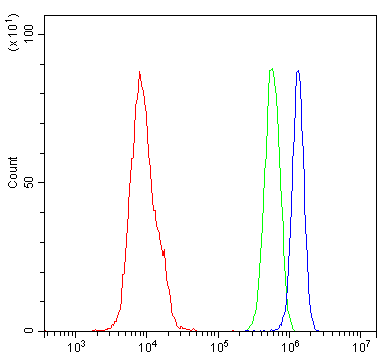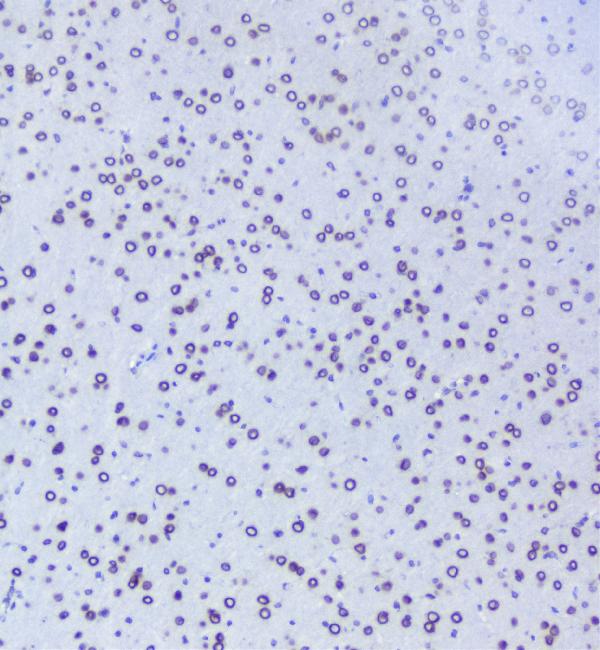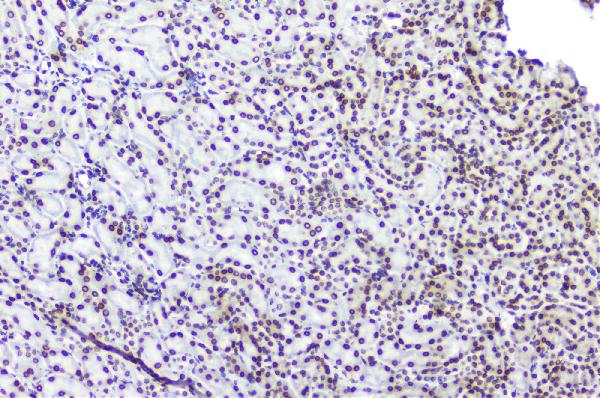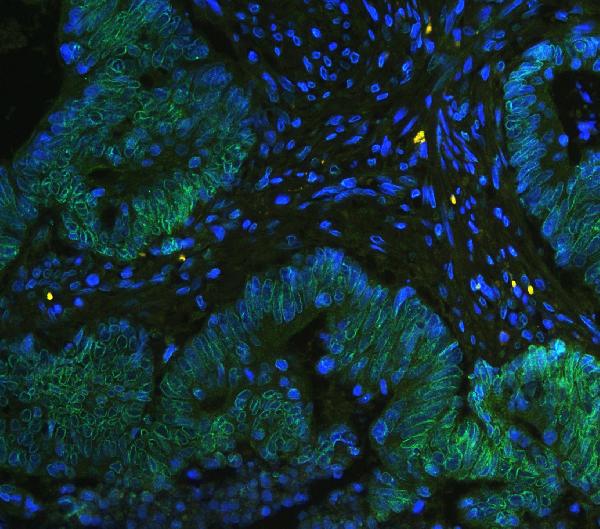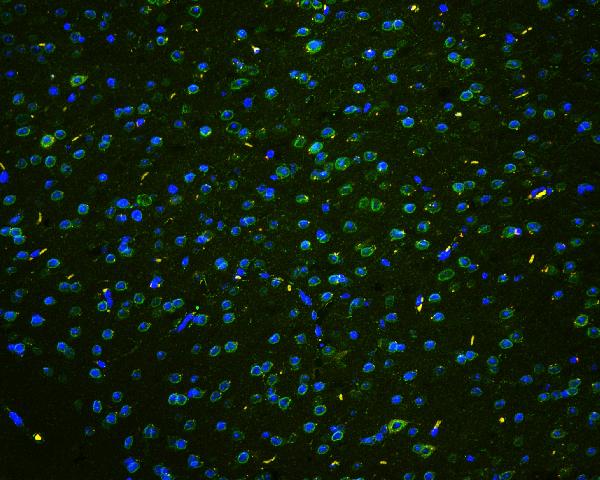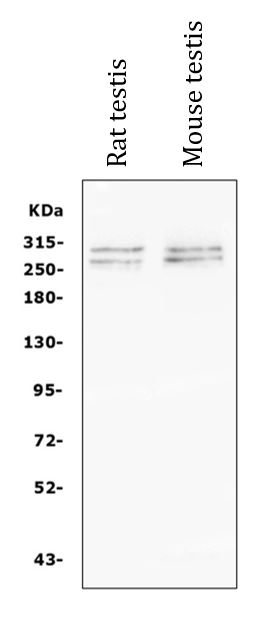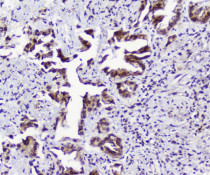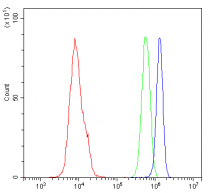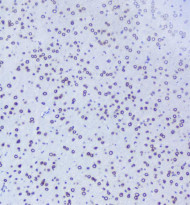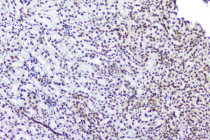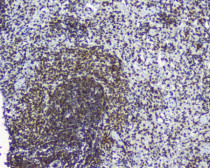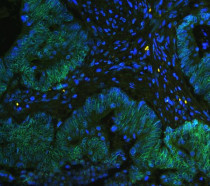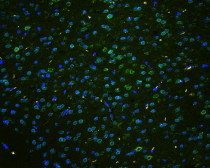anti-TPR antibody
| 产品描述 | Rabbit Polyclonal antibody recognizes TPR |
|---|---|
| 反应物种 | Hu, Ms, Rat |
| 应用 | FACS, IHC-P, WB |
| 宿主 | Rabbit |
| 克隆 | Polyclonal |
| 同位型 | IgG |
| 靶点名称 | TPR |
| 抗原物种 | Human |
| 抗原 | Synthetic peptide corresponding to a sequence of Human TPR. (MLQAEKKLLEEDVKRWKARNQHLVSQQKD) |
| 偶联标记 | Un-conjugated |
| 別名 | Nucleoprotein TPR; Translocated promoter region protein; NPC-associated intranuclear protein; Megator |
| 应用建议 |
| ||||||||
|---|---|---|---|---|---|---|---|---|---|
| 应用说明 | IHC-P: Antigen Retrieval: Heat mediation was performed in Citrate buffer (pH 6.0) for 20 min. * The dilutions indicate recommended starting dilutions and the optimal dilutions or concentrations should be determined by the scientist. | ||||||||
| 实际分子量 | ~ 270, 300 kDa |
| 形式 | Liquid |
|---|---|
| 纯化 | Affinity purification with immunogen. |
| 缓冲液 | 0.2% Na2HPO4, 0.9% NaCl, 0.05% Sodium azide and 4% Trehalose. |
| 抗菌剂 | 0.05% Sodium azide |
| 稳定剂 | 4% Trehalose |
| 浓度 | 0.5 mg/ml |
| 存放说明 | For continuous use, store undiluted antibody at 2-8°C for up to a week. For long-term storage, aliquot and store at -20°C or below. Storage in frost free freezers is not recommended. Avoid repeated freeze/thaw cycles. Suggest spin the vial prior to opening. The antibody solution should be gently mixed before use. |
| 注意事项 | For laboratory research only, not for drug, diagnostic or other use. |
| 数据库连接 | |
|---|---|
| 基因名称 | TPR |
| 全名 | translocated promoter region, nuclear basket protein |
| 背景介绍 | This gene encodes a large coiled-coil protein that forms intranuclear filaments attached to the inner surface of nuclear pore complexes (NPCs). The protein directly interacts with several components of the NPC. It is required for the nuclear export of mRNAs and some proteins. Oncogenic fusions of the 5' end of this gene with several different kinase genes occur in some neoplasias. [provided by RefSeq, Jul 2008] |
| 生物功能 | Component of the nuclear pore complex (NPC), a complex required for the trafficking across the nuclear envelope. Functions as a scaffolding element in the nuclear phase of the NPC essential for normal nucleocytoplasmic transport of proteins and mRNAs, plays a role in the establishment of nuclear-peripheral chromatin compartmentalization in interphase, and in the mitotic spindle checkpoint signaling during mitosis. Involved in the quality control and retention of unspliced mRNAs in the nucleus; in association with NUP153, regulates the nuclear export of unspliced mRNA species bearing constitutive transport element (CTE) in a NXF1- and KHDRBS1-independent manner. Negatively regulates both the association of CTE-containing mRNA with large polyribosomes and translation initiation. Does not play any role in Rev response element (RRE)-mediated export of unspliced mRNAs. Implicated in nuclear export of mRNAs transcribed from heat shock gene promoters; associates both with chromatin in the HSP70 promoter and with mRNAs transcribed from this promoter under stress-induced conditions. Modulates the nucleocytoplasmic transport of activated MAPK1/ERK2 and huntingtin/HTT and may serve as a docking site for the XPO1/CRM1-mediated nuclear export complex. According to some authors, plays a limited role in the regulation of nuclear protein export (PubMed:22253824 and PubMed:11952838). Plays also a role as a structural and functional element of the perinuclear chromatin distribution; involved in the formation and/or maintenance of NPC-associated perinuclear heterochromatin exclusion zones (HEZs). Finally, acts as a spatial regulator of the spindle-assembly checkpoint (SAC) response ensuring a timely and effective recruitment of spindle checkpoint proteins like MAD1L1 and MAD2L1 to unattached kinetochore during the metaphase-anaphase transition before chromosome congression. Its N-terminus is involved in activation of oncogenic kinases. [UniProt] |
| 细胞定位 | Nucleus. Nucleus membrane; Peripheral membrane protein; Nucleoplasmic side. Nucleus envelope. Nucleus, nuclear pore complex. Cytoplasm. Cytoplasm, cytoskeleton, spindle. Chromosome, centromere, kinetochore. Nucleus membrane; Peripheral membrane protein; Cytoplasmic side. [UniProt] |
| 预测分子量 | 267 kDa |
| 翻译后修饰 | Phosphorylated. Phosphorylation occurs on serine and threonine residues (comprised in the C-terminal region) by MAPK1/ERK2 and stabilizes the interaction between these two proteins. Proteolytically degraded after poliovirus (PV) infection; degradation is restricted to its unfolded C-terminal tail domain whereas its coiled-coil domain containing NCP- and NUP153-binding domains withstand degradation. [UniProt] |
ARG42924 anti-TPR antibody IHC-P image
Immunohistochemistry: Paraffin-embedded Human lung cancer tissue. Antigen Retrieval: Heat mediation was performed in Citrate buffer (pH 6.0) for 20 min. The tissue section was blocked with 10% goat serum. The tissue section was then stained with ARG42924 anti-TPR antibody at 1 µg/ml dilution, overnight at 4°C.
ARG42924 anti-TPR antibody WB image
Western blot: 50 µg of sample under reducing conditions. HeLa, SW620 and MDA-MB-231 whole cell lysates stained with ARG42924 anti-TPR antibody at 0.5 µg/ml dilution, overnight at 4°C.
ARG42924 anti-TPR antibody FACS image
Flow Cytometry: U937cells were blocked with 10% normal goat serum and then stained with ARG42924 anti-TPR antibody (blue) at 1 µg/10^6 cells for 30 min at 20°C, followed by incubation with DyLight®488 labelled secondary antibody. Isotype control antibody (green) was Rabbit IgG (1 µg/10^6 cells) used under the same conditions. Unlabelled sample (red) was also used as a control.
ARG42924 anti-TPR antibody IHC-P image
Immunohistochemistry: Paraffin-embedded Mouse brain tissue. Antigen Retrieval: Heat mediation was performed in Citrate buffer (pH 6.0) for 20 min. The tissue section was blocked with 10% goat serum. The tissue section was then stained with ARG42924 anti-TPR antibody at 1 µg/ml dilution, overnight at 4°C.
ARG42924 anti-TPR antibody IHC-P image
Immunohistochemistry: Paraffin-embedded Mouse kidney tissue. Antigen Retrieval: Heat mediation was performed in Citrate buffer (pH 6.0) for 20 min. The tissue section was blocked with 10% goat serum. The tissue section was then stained with ARG42924 anti-TPR antibody at 1 µg/ml dilution, overnight at 4°C.
ARG42924 anti-TPR antibody IHC-P image
Immunohistochemistry: Paraffin-embedded Rat spleen tissue. Antigen Retrieval: Heat mediation was performed in Citrate buffer (pH 6.0) for 20 min. The tissue section was blocked with 10% goat serum. The tissue section was then stained with ARG42924 anti-TPR antibody at 1 µg/ml dilution, overnight at 4°C.
ARG42924 anti-TPR antibody IHC-P image
Immunohistochemistry: Paraffin-embedded Human intestinal cancer tissue. Antigen Retrieval: Heat mediation was performed in Citrate buffer (pH 6.0) for 20 min. The tissue section was blocked with 10% goat serum. The tissue section was then stained with ARG42924 anti-TPR antibody at 1 µg/ml dilution, overnight at 4°C.
ARG42924 anti-TPR antibody IHC-P image
Immunohistochemistry: Paraffin-embedded Mouse brain tissue. Antigen Retrieval: Heat mediation was performed in Citrate buffer (pH 6.0) for 20 min. The tissue section was blocked with 10% goat serum. The tissue section was then stained with ARG42924 anti-TPR antibody at 1 µg/ml dilution, overnight at 4°C. DAPI (blue) for nuclear staining.
ARG42924 anti-TPR antibody WB image
Western blot: 50 µg of sample under reducing conditions. Rat testis and Mouse testis lysates stained with ARG42924 anti-TPR antibody at 0.5 µg/ml dilution, overnight at 4°C.
 New Products
New Products





